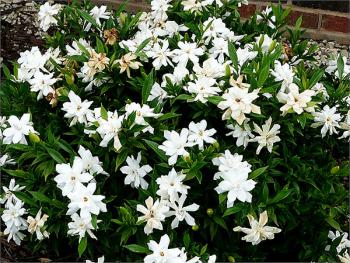
It’s too late in the season to prune many spring-flowering shrubs, such as this frostproof gardenia. But many non-flowering shrubs need care now.
--LSU AgCenter/Dan Gill
Now is the last chance to prune, fertilize many plants
August is a month when gardeners should think about two important aspects of landscape maintenance — fertilizing and pruning. This month is the latest to fertilize lawns, hardy shrubs and ground covers in the landscape. Now is also the time to finish up pruning many shrubs, cut back overgrown tropicals and trim some bedding plants. But it’s also time to stop pruning spring-flowering trees and shrubs.
You can use granular general-purpose fertilizers for most fertilizing jobs in the landscape. These fertilizers are relatively inexpensive and easy to use.
They provide an immediate release of nutrients and continue to feed for about six to eight weeks. If you feel you need to fertilize your lawn, shrubs or ground covers to encourage one last burst of growth, it’s important to do so now. Applications made this month will continue to feed until October, after which time it’s not appropriate for hardy plants to continue to receive supplemental nutrients.
As we move into the winter, it’s important that hardy plants in the landscape slow their growth and prepare for the coming cold. Late fertilizer applications, especially with nitrogen, can increase the possibility of cold damage, even to plants that would normally be hardy. This is especially true in Louisiana because fall temperatures are generally warm to mild and don’t give plants a strong signal to go dormant.
For lawns, granular fertilizers should be applied evenly to dry, freshly mowed turf and immediately watered in. Pay careful attention to the rate of application and spread the fertilizer evenly. This is difficult to do by hand, so use a fertilizer spreader to ensure even coverage.
Shrubs and ground covers may be fertilized by sprinkling fertilizer in the bed where they are growing. You may also apply fertilizer by sprinkling it around each plant. The size of the shrubs is a factor in determining the amount of fertilizer used. Rates are generally higher for larger shrubs, but check package recommendations for specific amounts.
I’m not necessarily saying you should go out and fertilize plants in your landscape now. Most landscape plants don’t need to be fertilized at this time. Spring fertilizer applications are more important.
If your lawn, shrubs and ground covers look healthy and have grown well this summer, there should be little indication that fertilizer is needed. If, on the other hand, you have some plantings you have been meaning to fertilize or you feel would benefit from fertilization to boost their vigor, now is the time to do it — not later.
Pruning is another topic that gardeners need to focus on at this time. Fall-, winter- and spring-flowering trees and shrubs — those that bloom from November through April, such as sasanquas, camellias, azaleas, spireas, Indian hawthorns, cherries and Oriental magnolias, as well as summer-flowering gardenias and hydrangeas — have already set their flower buds for next year. Extensively pruning or cutting back these plants from now on will generally diminish or eliminate their flower display. It’s all right to selectively remove specific shoots or branches to shape these plants without affecting the flowering of the remaining growth. Just don’t get carried away.
Hedges, such as ligustrum, boxwood, photinia and viburnum, should be pruned by mid-September. Later pruning stimulates new growth during warm fall temperatures, and the plants will not have time to harden off before winter. This can increase the chance of freeze damage.
Hybrid tea and grandiflora roses should be cut back fairly hard in late August or early September. Other types of everblooming roses may also be pruned back one-third to one-half their height as needed to shape, stimulate vigorous new growth, remove dead or diseased canes, or control the size of the bush.
Our long growing season allows for the abundant growth of tropicals and tender perennials used as bedding plants in our gardens. In many cases, they look somewhat overgrown now, but they will continue to grow and bloom until October or early November. Now is an excellent time to trim them back or even cut them back fairly hard so they will be shapelier, fuller and not so tall for the fall blooming period.
Popular bedding plants that benefit from trimming now include periwinkle, salvia, lantana, Mexican heather, blue daze, pentas, scaevola, purslane, begonia, impatiens and ornamental peppers. How far back you prune them depends on how overgrown you think yours are. Generally, plants are cut back about one-third to one-half their height, but I have cut many of the plants listed above back farther with good results.
I must admit this takes some determination and a strong will. Your plants will certainly not look their best immediately after the procedure. In many instances, though, it is well worth the down time. If some of these plants look overgrown now, think of how they will look by October.
- Log in to post comments
